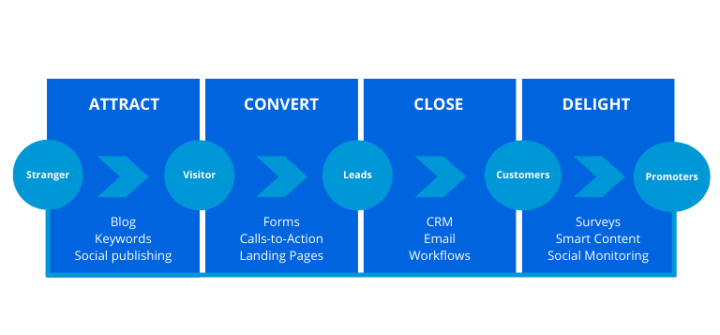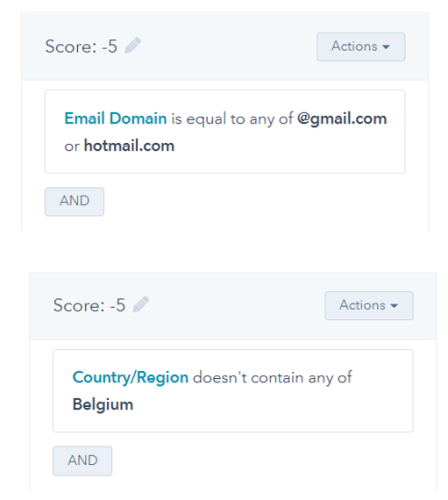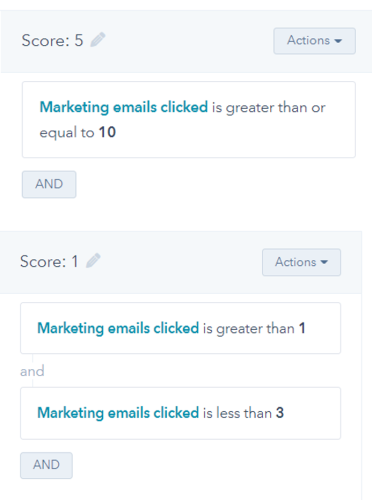How do you set up a good lead scoring strategy?
As we said in one of our previous blog posts: sales and marketing alignment is crucial to find leads and follow them up efficiently. But did you know that lead scoring can help you automate sales and marketing alignment? In addition, it helps you get a better overview of the funnel stage your leads are in. Are they in the decision stage and ready for sales, or are they still discovering what kind of solution might be interesting for them? In this blogpost, we answer the question: how do you set up a good lead scoring strategy?

What is lead-scoring?
Before we starte explaining the how, let’s take a minute too explain what lead scoring is. Lead scoring is a process where you assign points to certain characteristics or actions of the contacts in your CRM. You can include both explicit and implicit data in your lead scoring mix.
By the way: notice we mentioned contacts in the database, not leads. Think about it: any contact should get a lead score, even though they might not be a lead. More about that later.
Explicit data: this is information about the person/company in question, like a job title, their industry, country, seniority… This information indicates how well the person or company in question matches your ideal target audience. Usually you get this information from forms filled out on the website, social media or certain databases you might be using.
Implicit data: The interaction your contacts have with content. e.g. the number of emails opened, number of clicks, number of downloads of a lead magnet, viewing a pricing page, attending your webinars….
Now, each of these actions or characteristics gets a predefined number of points. These are added together every time something happens. This is how you get a lead score for every contact. The higher the score, the more active someone is and the better they match your image of the ideal customer. This way, you get a list of highly qualified leads that your sales team can focus on.
Buyer persona
When you base your scores only on implicit information, you miss out on an important aspect: your customer fit. Not everyone that downloads your content for example is your ideal customer. Some companies specifically target certain countries or industries, or departments within companies. So it’s important to include this in your lead scoring model. Otherwise you end up with a bunch of irrelevant customers in your list. Having your sales team work on these leads would be a total waste of time and resources.
By defining clear buyer persona’s and including these data in your lead scoring, you ensure that only contacts matching your ideal customer profile end up in your list. A buyer persona is a semi-fictitious representation of your ideal customer, and this usually includes demographic characteristics like their age, education level, personality traits and so on, and also the type of company they likely work for, their goals and challenges. Defining your buyer persona is definitely worth it, and our worksheet can help you with that.
Once you get your buyer personas crystal clear, it’s easy to determine what characteristics are essential for your lead scoring. Think of this as a kind of traffic light. Does the person fit the picture? For example, are they in the right industry, or in the right country? Do they have the seniority level you are looking for? If so, the light turns green and points are awarded. Is one of these things not correct, or unknown? Then the light turns red and no points are awarded. You could even deduct points. What criteria to include in your lead scoring is something to discuss with your sales team. After all, they are in direct contact with your leads and customers, and therefore know better than anyone what characteristics matter to your organization.
Interaction with your content
Nw that you know what your ideal customer looks like, it’s time to start looking at how your leads interact with your contact. In fact, this is the implicit part of lead scoring. These elements can be an indication what stage of the buyer’s journey your leads are in. This enables a proper follow-up.
Here are some examples of content we look at:
- Downloads
- Opening and clicking emails
- Viewing website pages
- Viewing specific pages (e.g. pricing page)
- Filling out contact forms
- Attending webinars
- Reading blogposts
- Social media engagement
- Requesting a demo
As you can see, the possibilities are virtually endless. Everything that can be tracked in your CRM (e.g. Hubspot), you can also use in your lead scoring. Moreover, you don’t have to limit yourself to interactions that indicate a direct purchase intent. Even smaller interactions such as opening emails can be relevant to include in lead scoring. After all, opening 1 single email does not indicate a purchase intent, but someone who is going to open all your emails multiple times might be a potential customer.
How do you set up lead scoring?
So now the burning question is: how exactly do you set these scores up? The answer to that question is unfortunately not as straightforward as you might thing. Everything depends on your business.
Input from sales
Having a conversation with your sales colleagues is a great way to start. Like I mentioned before, they have the most up to date information about your customers. They know what interests them, what information they are looking for in their decision making process, how this process works for them, what characteristics are crucial for a successful deal… Based on this, you can start ranking the different explicit and implicit triggers. For example, someone who views a pricing page twice will be given a higher score than someone who opened your monthly newsletter. That’s because it signifies the first person in this example is already further along in the buyer’s journey, and is therefore a warmer lead.
Points
Now, you can add points, but you can also subtract them. Especially for explicit information, this can be an interesting way to score leads. Let’s say you want to follow up only leads from the EU. You could apply a negative score for every contact in your database that’s not in the EU. This way you can make sure these contacts don’t end up in your list of top scorers or SQL’s, no matter how much they interact with your content. Another example: in a B2B context, you can also give negative points for email addresses including gmail.com and the likes.

The scoring system
After ranking both explicit and implicit information, it is time to assign points to the specific actions or information. Here are some pointers:
- Keep the interval between points small. We often see companies use increments of 10 or 100. But a smaller interval gives you more control: you avoid people suddenly scoring really high scores and rank at the top of your list, while not being your warmest lead. Small increments also give you a better overview who ranks high or low.
- Take into account the number of times your contacts perform specific actions. 10 clicks in e-mails can be equally as valuable as one white paper download, or 3 webinar registrations. For these 3 examples, your lead should get the same amount of points. How valuable each action is, is up for you to decide.

Threshold value
The ultimate goal of your lead scoring is the automation lead nurturing and the transfer from marketing to sales, and back if needed. Based on the scores you assign, you can start defining the threshold value: this is the score that indicates when someone becomes an SQL (Sales Qualified Lead). This type of lead is ready to start talking to your sales people, they are considering a purchase. So when they reach this threshold value, it’s time for your sales team to take the appropriate action.
In the beginning however, it’s not easy to determine this threshold value. You’ll need a few rounds of testing to finetune this. Like before, your sales team can provide valuable input here. An example: your sales team could tell you from experience that people who downloaded 2 content offers and have viewed your pricing page, are ready to talk to sales. Then you dive into the scores and set this as your threshold value in your scoring system. However, bear in mind that other combinations of actions can also make someone an SQL, and don’t forget to account for explicit information as well.
What if your CRM is very basic?
Many CRM’s like Hubspot will support lead scoring. But many CRM’s don’t. What if your specific CRM does not offer any lead scoring options, or what if you don’t have enough content and therefore don’t lack the touch points to score leads? Not too worry: in this case you can simplify lead scoring, by working with a few categories.
Let’s say someone attended your webinar. You could mark them as a hot lead. The next person could view a few high value pages on your website, and could therefore be marked as a warm lead. And another person could have done the same, but is in a country you don’t serve, so they can be marked as a cold lead.
Lead scoring is definitely a very valuable way to bring your lead nurturing and qualification of leads to the next level. But as with so many other marketing activities you do, this will take some testing in the beginning. This initial investment, mostly in time spent, can really make your marketing and sales team much more aligned. You’ll reap so many efficiency benefits in the long run, so we can only recommend to get started setting up your own lead scoring system.
Get more marketing insights
Thank you for being here and reading our blog. If you want to get more marketing insights and invitations for events, then don’t hesitate and register for our email updates.






